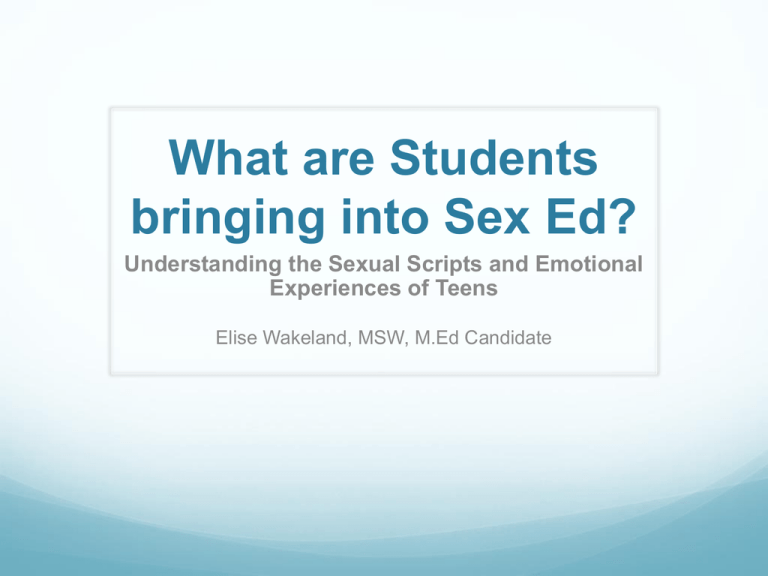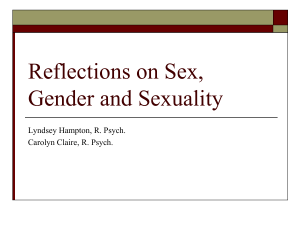
What are Students
bringing into Sex Ed?
Understanding the Sexual Scripts and Emotional
Experiences of Teens
Elise Wakeland, MSW, M.Ed Candidate
Goal and Objectives
Educators who understand the sexual scripts and emotional
experiences of their students are better prepared to meet the
needs of teenage learners.
Objectives:
Through this workshop, sex educators will be able to:
- Define the term sexual scripts and understand sexual scripts
occurring during adolescence.
- Understand the feelings of students surrounding hook ups and
sexual trauma within adolescence.
- Begin to apply this information to lessons on consent and healthy
relationships.
Sexual Scripts
Our sexual behaviors, sexual attitudes, and desires
are dictated by a set of “scripts” that are used to
organize and interpret sexual encounters
A cognitive schema which gives us a “script” or
framework for how to act in sexual situations
(Garcia, Reiber, Massey, & Merriwether, 2012)
Sexual Scripts
Teen sexual scripts can be influenced by MANY factors
Culture
Media
Peers
Family
Religious affiliation
Past experiences
Types of Sexual Scripts
Sexual Scripts can influence us on multiple
INTERACTIVE levels
Cultural
The norms that guide sexual
behavior at the societal, cultural,
and subcultural level which help
to determine the details (who,
what, when, where, and how) of
sexual encounters.
Individual
Utilizing relational
and cultural levels to
construct one’s own
desire and fantasy
Relational
Individual interpretations
of cultural norms and
considers personal
experiences,
socialization, and desires
to shape action in a
sexual situation.
(Dworkin & Sullivan, 2005)
Examples: Types of Sexual
Scripts
Cultural
• Traditional,
gendered notions
Individual
• “I like tall,
handsome, and
broad men”
• “I need oral sex
before
penetrative sex”
Relational
•
•
Experiences of
sexual assault
Loving and healthy
sexual experiences
(Dworkin & Sullivan, 2005)
Sexual Scripts of Teens
Masters, Casey, Wells, and Morrison (2013) asked the
question:
What do the sexual scripts of teens
resemble?
Cultural Level
Individual/Relational
Level
Cultural Level Sexual Scripts
Most teens have cultural level sexual scripts dictated by
Traditional, mainstream, hegemonic, masculine and
feminine sexuality
Examples:
“Men should initiate sex”
“Men want sex, women want love”
“Women should be less sexually experienced,”
“Women are to be desired not desiring sex”
(Masters et al., 2013)
Individual and Relational
Sexual Scripts
There are three groups of interpersonal/intrapersonal
sexual scripts that heterosexual teens fall into:
Conforming
Exception Finding
Transforming
Masters et. al (2013)
Conforming Sexual Scripts
Teens whose individual and relational sexual scripts
mirrored the traditional, roles of men and women
Examples:
“Hooking up with her was great, but then she wanted a
relationship. She was just too clingy. Why is it all women
always want relationships?”
“I grew up with messages about Prince Charming… and
what can I say… that is what I want! Someone to fall in love
with”
(Masters et al., 2013)
Exception Finding Sexual
Scripts
Teens who accept the culture-level gender scripts as a
given, and created exceptions to gender rules for themselves or on finding partners
Examples:
“I’m not like the players who just sleep around with girls. I
want a relationship.”
“I like having sex with people without strings, but I don’t want
many people to know about it. I don’t want to be considered
a slut.”
(Masters et al., 2013)
Transforming Sexual Scripts
Teens who construct their own individual/relational
sexual scripts
Scripts DIFFERENT from the main stream, traditional
gender roles!
Example
“Sexuality should be mutually rewarding and consensual for
both partners.”
“Guys tend to try to prove how masculine they are… But I
just don’t want to do that. It doesn’t have to be like that”
How about the scripts of our
LGBT students?
Limited Research
Mutchler (2000) looked at the sexual scripts of gay
male youth.
Adapt cultural level scripts
Seek out safe subcultures and situations which fit their
individual and relational sexual scripts
Examples of adaptation to sexual scripts that occur for
gay men
Safer sex: Gay men recognize the need for safer
sex….which is integrated into their individual/relational
LGBT Sexual Scripts
“Traditional sexual scripts fail to adequately theorize the
complexities and contradictions in the erotic lives of gay
and straight individuals, but they do provide building
blocks from which sexual actors may write their own
scripts for sex.”
(Mutchler, 2000)
SEX ED
Sexual
Abuse
Peers
Experience
as a sexual
minority
Family
messages
Personal
Experiences
Religious
messages
Hook ups
Emotional
abuse
Healthy
relationships
COMING INTO THE
CLASSROOM
Personal
Experiences
IndividualRelational
Sexual Scripts
FEELINGS
Hook Ups
Prevalence: 81% of undergraduate engaged in some
form of hookup behavior
Multiple studies report the prevalence of alcohol use
within hook ups as a means to initiate and progress a
sexual encounters.
(Garcia et al., 2012)
Feelings and Hook Ups
General perception that everyone does this and enjoys
it. Research:78% of individuals overestimated others’
comfort with hook up
Positive feelings during the hook up
Predominant feelings after a hook up:
Shame
Guilt
Vulnerability
Regret
Disappointment Worry
(Garcia et al., 2012)
Prevalence of History of
Sexual Violence
25% of teens have experienced physical, emotional, or
sexual abuse within a relationship.
12% of girls in grades 9-12
5% of boys grads 9-12
https://www.rainn.org/get-information/statistics/sexual-assault-victims
Student Experiences of
Unwanted Sexual Activity
Even when sexual consent is present Sexual
activity may not be wanted:
Peterson and Muelenhard (2007) found that
55% of females and 35% of males had
consented to unwanted sexual activity
(Peterson and Muehlenhard, 2007)
Feelings and Sexual Abuse
Shame
Guilt
Sadness
Fear
Anxiety
Dissociation
Anger
Confusion
Isolation
https://www.rainn.org/get-information/statistics/sexual-assault-victims
So…what does this look like
in the classroom?
Davis (2005) suggests the following can occur
in a sexuality class:
Individuals who associate the material (for
any reason) with SHAME, GUILT, ANXIETY,
and/or PAIN Keep quiet.
Sexual extraverts, sexually liberal, and those
for whom sex is associated with positivity
dominate class discussions
(Davis, 2005)
“If emotions are left simmering, unattended
to, and unacknowledged, students can
become distracted and unable to engage”
(Davis, 2005)
Activity: Putting yourself in a
student’s shoes
You have all just become high school students!! Wahoo!!
You are in sex ed and learning about consent.
Pair up and discuss the
following:
What are your student’s possible sexual
scripts?
What is your student possibly thinking and
feeling during this lesson?
How might this influence their ability to learn
the material?
References
Davis, N. (2005). Taking sex seriously: Challenges in teaching about sexuality. Teaching Sociology, 33,
16-31.
Dworkin, S. L., & O’Sullivan, L. (2005). Actual versus desired initiation patterns among a sample of
college men: Tapping dis- junctures within traditional male scripts. Journal of Sex Research, 42, 150–
158.
Garcia, J., Reiber, C., Massey, S., & Merriwether, A. (2012). Sexual hookup culture: A review. Review of
General Psychology,16(2), 161-176.
Little, S., Akin-Little, A., & Somerville, M. (2011). Response to trauma in children: An examination of
effective intervention and post-traumatic growth. School Psychology International, 32(5), 448-463.
Masters, N., Casey, E., & Wells, E., & Morrison, D. (2013). Sexual scripts among young heterosexually
active men and women: continuity and change. Journal of Sex Research, 50(5), 409-420.
Peterson, Z. D., & Muehlenhard, C. L. (2007). Conceptualizing the ‘‘wantedness’’ of women’s
consensual and nonconsensual sexual experiences: Implications for how women label their
experiences with rape. Journal of Sex Research, 44, 72–88.
Perry, K., Gottwald, L., Martin, M., & McKee, B. (2011). Last friday night. On Teenage dream [CD]. New
York, NY: Capitol Records.
Ryan, K. (2011). The relationship between rape myths and sexual scripts: The social construction of
rape. Sex Roles, 65, 774-782.









